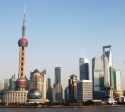
Fast rising inequality in China: what can be done about it?
As remarkable as its economic growth, China’s income distribution has been worsening since mid-1980s. Inequality across regions, occupations and between individual all rose dramatically. More importantly, it did so in a short time.
Par Guanghua Wan
Guanghua Wan, Principal Economist at the Asian Development Bank (ADB), will be presenting his work in a coming Club du CEPII conference. For more information on the event and to register, please click here.
This has adversely affected domestic demand and generated enormous psychological pressure on the relatively deprived, leading to serious social and economic problems. It is commonly accepted that inequality is eroding political and social stability.
Despite its importance, rather limited knowledge on inequality in China is available. Only in early 2013 and under considerable pressure did the Chinese government release the Gini index – a measure of inequality, but only for the period of 2003-2012. A sizeable literature on inequality in China does exist but it largely focuses on its measurement. This is not very helpful as effective policy-making requires knowledge on its causes or drivers, not just its measurement.
In a 2007 paper I co-authored, we discovered that 70-80% of China’s regional inequality can be attributed to the urban-rural gap. More recently, we found that about one third of inter-household inequality is caused by the same gap. Further, inter-sector disparity (this is, unequal wages across different occupations) constituted some 15% of the total inter-household inequality. What is more striking is that these contributions or components have been rising over time.
By international norm, China only needs to cut down inequality by 20-30%. But eliminating urban-rural and inter-sector income gaps can halve inequality in China. Unfortunately, so far China has done little or has not done the right thing on these two gaps.
The inter-sector gap is intrinsically linked to the state monopoly over super profit-making industries such as energy, banking, railways and freeways, and telecommunications. It is not clear how these monopolies can be broken down while maintaining state control. The matter becomes much more complicated once we note the growing alliance between the rich and the powerful.
The solution to the urban-rural gap lies in urbanization. On average, a rural resident earns less than one third of a urban resident. Although the Chinese government has been pro-rural in various ways, the long-standing Hukou or household registration system has prevented the majority of China’s citizens to share the growth dividends which have been largely produced in cities. Until labor and households can freely move across locations and between countryside and cities, and with equal rights and social welfare, inequality will remain a serious obstacle to China’s growth and prosperity.
More research findings are available at: http://ideas.repec.org/f/pwa395.html.
Economies émergentes
< Retour
This has adversely affected domestic demand and generated enormous psychological pressure on the relatively deprived, leading to serious social and economic problems. It is commonly accepted that inequality is eroding political and social stability.
Despite its importance, rather limited knowledge on inequality in China is available. Only in early 2013 and under considerable pressure did the Chinese government release the Gini index – a measure of inequality, but only for the period of 2003-2012. A sizeable literature on inequality in China does exist but it largely focuses on its measurement. This is not very helpful as effective policy-making requires knowledge on its causes or drivers, not just its measurement.
In a 2007 paper I co-authored, we discovered that 70-80% of China’s regional inequality can be attributed to the urban-rural gap. More recently, we found that about one third of inter-household inequality is caused by the same gap. Further, inter-sector disparity (this is, unequal wages across different occupations) constituted some 15% of the total inter-household inequality. What is more striking is that these contributions or components have been rising over time.
By international norm, China only needs to cut down inequality by 20-30%. But eliminating urban-rural and inter-sector income gaps can halve inequality in China. Unfortunately, so far China has done little or has not done the right thing on these two gaps.
The inter-sector gap is intrinsically linked to the state monopoly over super profit-making industries such as energy, banking, railways and freeways, and telecommunications. It is not clear how these monopolies can be broken down while maintaining state control. The matter becomes much more complicated once we note the growing alliance between the rich and the powerful.
The solution to the urban-rural gap lies in urbanization. On average, a rural resident earns less than one third of a urban resident. Although the Chinese government has been pro-rural in various ways, the long-standing Hukou or household registration system has prevented the majority of China’s citizens to share the growth dividends which have been largely produced in cities. Until labor and households can freely move across locations and between countryside and cities, and with equal rights and social welfare, inequality will remain a serious obstacle to China’s growth and prosperity.
More research findings are available at: http://ideas.repec.org/f/pwa395.html.
|
Retrouvez plus d'information sur le blog du CEPII. © CEPII, Reproduction strictement interdite. Le blog du CEPII, ISSN: 2270-2571 |
|||
|

